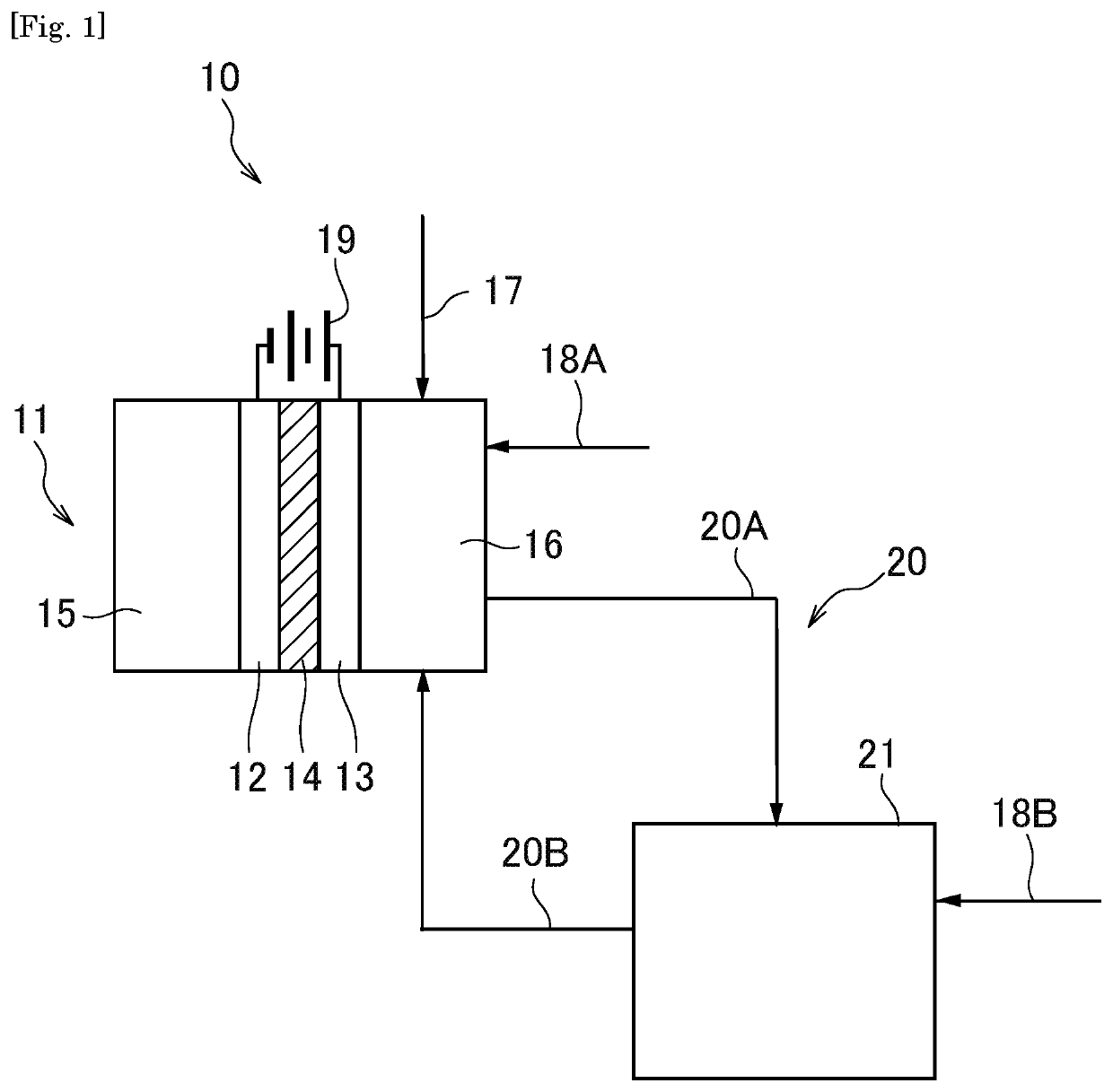Synthetic method and synthetic system
a synthetic method and system technology, applied in the field of synthetic methods and systems, can solve the problem of not being able to indicate a sufficiently efficient reaction scheme, and achieve the effect of efficiently and practically synthesizing an organic compound
- Summary
- Abstract
- Description
- Claims
- Application Information
AI Technical Summary
Benefits of technology
Problems solved by technology
Method used
Image
Examples
first embodiment
[0033]A synthesis system 10 according to a first embodiment of the present invention comprises a first electrochemical cell11 comprising a cathode 12 and an anode 13, and a first reactor 21.
[0034]In the first electrochemical cell 11, a step of producing a carbonate compound from carbon monoxide and an alcohol-based compound at the side of the anode (first step) is performed. In the first reactor 21, a step of synthesizing a first product by a dealcoholization reaction of the carbonate compound obtained in the first electrochemical cell 11 (second step) is performed, and an alcohol-based compound eliminated in the second step is recycled in the first step.
[0035]In the present embodiment, an alcohol-based compound produced as a by-product in synthesis of the first product can be recycled in an electrochemical reaction performed in the first electrochemical cell 11, and therefore the first product can be efficiently and practically synthesized.
[0036]In the following description, an alc...
second embodiment
[0179]Next, a second embodiment of the present invention will be described.
[0180]A synthesis system 30 according to the second embodiment of the present invention comprises a second reactor 22 that is a separate reactor from the first reactor 21, in addition to the configuration of the first embodiment, as illustrated in FIG. 2. Hereinafter, the synthesis system of the second embodiment will be described with respect to differences from the synthesis system of the first embodiment.
[0181]While the dealcoholization reaction of the carbonate compound is performed in only the first reactor 21 in the first embodiment as described above, it is performed in both the first and second reactors 21 and 22 in the present embodiment.
[0182]In the first reactor 21, the first product is produced while the alcohol-based compound (1) being eliminated, as in the first embodiment, and the alcohol-based compound eliminated is returned to the region at the side of the anode (namely, second electrochemica...
third embodiment
[0215]Next, a third embodiment of the present invention will be described.
[0216]While carbon monoxide used as a raw material is fed to the side of the anode of the first electrochemical cell 11 from one other than the first electrochemical cell 11 in the first embodiment, carbon monoxide produced at the side of the cathode of the first electrochemical cell 11 is fed to the side of the anode of the first electrochemical cell 11 in the third embodiment. Hereinafter, a synthesis system 35 according to the third embodiment of the present invention will be described with respect to differences from the synthesis system of the first embodiment, with reference to FIG. 3.
[0217]The synthesis system 35 of the third embodiment comprises a first connecting path 36. The first connecting path 36 connects the first electrochemical compartment 15 and the second electrochemical compartment 16, and feeds carbon monoxide produced in the first electrochemical compartment 15, to the second electrochemic...
PUM
| Property | Measurement | Unit |
|---|---|---|
| molar ratio | aaaaa | aaaaa |
| molar ratio | aaaaa | aaaaa |
| molar ratio | aaaaa | aaaaa |
Abstract
Description
Claims
Application Information
 Login to View More
Login to View More - R&D
- Intellectual Property
- Life Sciences
- Materials
- Tech Scout
- Unparalleled Data Quality
- Higher Quality Content
- 60% Fewer Hallucinations
Browse by: Latest US Patents, China's latest patents, Technical Efficacy Thesaurus, Application Domain, Technology Topic, Popular Technical Reports.
© 2025 PatSnap. All rights reserved.Legal|Privacy policy|Modern Slavery Act Transparency Statement|Sitemap|About US| Contact US: help@patsnap.com



